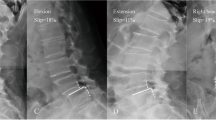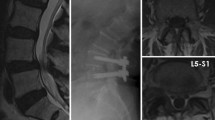Abstract
Introduction
Dynamic X-rays (DXR) are widely recognized as an effective method to detect lumbar instability (LI). They are usually performed with the patient in standing position (SDXR). In our opinion, standing position inhibits micromovements of the lumbar segment interested by the listhesis, thanks to paravertebral muscles antalgic contraction and augmented tone. We aim to demonstrate that DXR in recumbent position (RDXR), reducing the action of paravertebral muscles, can discover hypermovements not evidenced in SDXR.
Methods
Between January 2011 and January 2013, we studied 200 consecutive patients with lumbar degenerative disease with MRI, SDXR, and RDXR. We aimed to find a correlation between low back or radicular pain and the presence of a spondylolisthesis not showed by the SDXR, but showed by the RDXR.
Results
We analysed 200 patients: of the 133 not pathologic in SDXR, 43 patients (32.3 %) showed an hypermovement in RDXR (p = 0.0001) without any significant correlation between hidden listhesis and age, sex, or level involved.
Conclusions
The aim of our study is to determine whether in patients with lumbalgy without evidence of listhesis in SDXR, pain can be attributed to a faccettal syndrome or to a spondylolisthesis. Consequence of pain is augmented muscular tone of the paravertebral musculature, particularly in standing position. Augmented muscular tone tries to inhibit the pain generator, attempting to limit the slippage of the involved segment. In patients examined in RDXR, the tone of paravertebral musculature is reduced, showing the hidden spondylolisthesis.



Similar content being viewed by others
References
Pope MH, Panjabi M (1985) Biomechanical definitions of spinal instability. Spine (Phila Pa 1976) 10:255–256
Frymoyer JW, Selby DK (1985) Segmental instability. Rationale for treatment. Spine (Phila Pa 1976) 10:280–286
Watters WC, Bono CM, Gilbert TJ et al (2009) An evidence-based clinical guideline for the diagnosis and treatment of degenerative lumbar spondylolisthesis. Spine J 9:609–614. doi:10.1016/j.spinee.2009.03.016
Leone A, Guglielmi G, Cassar-Pullicino VN, Bonomo L (2007) Lumbar intervertebral instability: a review. Radiology 245:62–77. doi:10.1148/radiol.2451051359
Wood KB, Popp CA, Transfeldt EE, Geissele AE (1994) Radiographic evaluation of instability in spondylolisthesis. Spine (Phila Pa 1976) 19:1697–1703
Cabraja M, Mohamed E, Koeppen D, Kroppenstedt S (2012) The analysis of segmental mobility with different lumbar radiographs in symptomatic patients with a spondylolisthesis. Eur Spine J 21:256–261. doi:10.1007/s00586-011-1870-y
Hammouri QM, Haims AH, Simpson AK et al (2007) The utility of dynamic flexion-extension radiographs in the initial evaluation of the degenerative lumbar spine. Spine (Phila Pa 1976) 32:2361–2364. doi:10.1097/BRS.0b013e318155796e
Otani K, Okawa A, Shinomiya K, Nakai O (2005) Spondylolisthesis with postural slip reduction shows different motion patterns with video-fluoroscopic analysis. J Orthop Sci 10:152–159. doi:10.1007/s00776-004-0877-1
Penning L, Blickman JR (1980) Instability in lumbar spondylolisthesis: a radiologic study of several concepts. AJR Am J Roentgenol 134:293–301. doi:10.2214/ajr.134.2.293
Lowe RW, Hayes TD, Kaye J et al (1976) Standing roentgenograms in spondylolisthesis. Clin Orthop Relat Res :80–84.
Dupuis PR, Yong-Hing K, Cassidy JD, Kirkaldy-Willis WH (1985) Radiologic diagnosis of degenerative lumbar spinal instability. Spine (Phila Pa 1976) 10:262–276
Kanemura A, Doita M, Kasahara K et al (2009) The influence of sagittal instability factors on clinical lumbar spinal symptoms. J Spinal Disord Tech 22:479–485. doi:10.1097/BSD.0b013e31818d1b18
Posner I, White AA, Edwards WT, Hayes WC (1982) A biomechanical analysis of the clinical stability of the lumbar and lumbosacral spine. Spine (Phila Pa 1976) 7:374–389
Morgan FP, King T (1957) Primary instability of lumbar vertebrae as a common cause of low back pain. J Bone Joint Surg (Br) 39-B:6–22
Boden SD, Wiesel SW (1990) Lumbosacral segmental motion in normal individuals. Have we been measuring instability properly? Spine (Phila Pa 1976) 15:571–576
Hanley EN (1995) The indications for lumbar spinal fusion with and without instrumentation. Spine (Phila Pa 1976) 20:143S–153S
Kälebo P, Kadziolka R, Swärd L (1990) Compression-traction radiography of lumbar segmental instability. Spine (Phila Pa 1976) 15:351–355
Friberg O (1987) Lumbar instability: a dynamic approach by traction-compression radiography. Spine (Phila Pa 1976) 12:119–129
Pitkänen M, Manninen HI, Lindgrer KA et al (1997) Limited usefulness of traction-compression films in the radiographic diagnosis of lumbar spinal instability. Comparison with flexion-extension films. Spine (Phila Pa 1976) 22:193–197
Friberg O (1991) Instability in spondylolisthesis. Orthopedics 14:463–465
Pearcy M, Portek I, Shepherd J (1985) The effect of low-back pain on lumbar spinal movements measured by three-dimensional X-ray analysis. Spine (Phila Pa 1976) 10:150–153
Knutsson F (1944) The instability associated with disc degeneration in the lumbar spine. Acta Radiol 25:593–609
Panjabi MM (1992) The stabilizing system of the spine. Part I. Function, dysfunction, adaptation, and enhancement. J Spinal Disord 5:383–389, discussion 397
Panjabi MM (2003) Clinical spinal instability and low back pain. J Electromyogr Kinesiol 13:371–379. doi:10.1016/S1050-6411(03)00044-0
Panjabi MM (1992) The stabilizing system of the spine. Part II. Neutral zone and instability hypothesis. J Spinal Disord 5:390–396, discussion 397
Panjabi MM, Goel VK, Takata K (1982) Physiologic strains in the lumbar spinal ligaments. An in vitro biomechanical study 1981 Volvo Award in Biomechanics. Spine (Phila Pa 1976) 7:192–203
Kirkaldy-Willis WH, Farfan HF (1982) Instability of the lumbar spine. Clin Orthop Relat Res :110–123
Kreiner S, Shaffer WO, Baisden J, Gilbert T, Summers J, Toton J, Hwang S, Mendel R RC (2014) Evidence-based clinical guidelines for multidisciplinary spine care diagnosis and treatment of degenerative lumbar spinal stenosis. North Am. Spine Soc
Eck JC, Sharan A, Ghogawala Z, Resnick DK (2014) Guidelines for the performance of fusion procedures for degenerative disease of the lumbar spine. Part 7: intractable low-back pain without stenosis or spondylolisthesis. J Neurosurg Spine 2:670–672. doi:10.3171/2014.4.SPINE14270
Chaparian A, Kanani A, Baghbanian M (2014) Reduction of radiation risks in patients undergoing some X-ray examinations by using optimal projections: a Monte Carlo program-based mathematical calculation. J Med Phys 39:32–39. doi:10.4103/0971-6203.125500
Ethical standards and patient consent
We declare that this manuscript does not contain clinical studies or patient data.
Conflict of interest
NM consults for B-Braun.
Author information
Authors and Affiliations
Corresponding author
Rights and permissions
About this article
Cite this article
Landi, A., Gregori, F., Marotta, N. et al. Hidden spondylolisthesis: unrecognized cause of low back pain? Prospective study about the use of dynamic projections in standing and recumbent position for the individuation of lumbar instability. Neuroradiology 57, 583–588 (2015). https://doi.org/10.1007/s00234-015-1513-9
Received:
Accepted:
Published:
Issue Date:
DOI: https://doi.org/10.1007/s00234-015-1513-9




